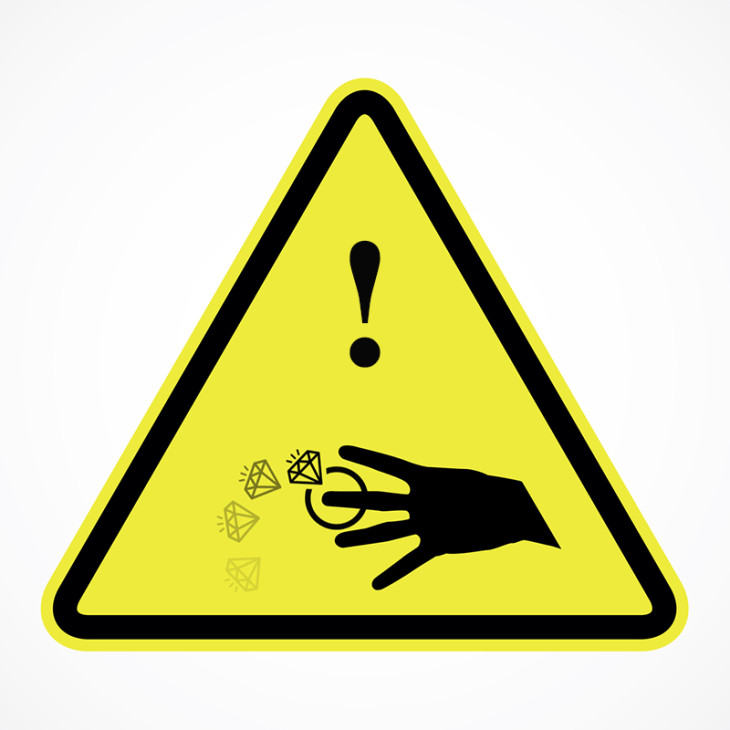8 Reasons why diamonds are lost from engagement rings
Some of our work involves replacing lost diamonds from ring settings, which unfortunately happens despite best efforts to safeguard against such occurrences. Despite great care, it might well be something that happens to your own ring.
Our first piece of advice is to arrange adequate insurance for your jewellery. Insurance can never be purchased when you need it, so please keep this in mind and act sooner rather than after the event.
Most jewellery insurance will cover loss or accidental damage. (Please read your policy or speak to a specialist for details of your cover).
The following are 8 of the most common reasons why diamonds are lost from engagement ring and diamond ring settings. Some of the following reasons overlap but break down into 8 main areas of risk.
1. Damage to the ring setting
Accidental damage to the setting can result in the loss of your diamond. Claws can bend or break depending on the extent of damage. Over time, claws that are thinner and, therefore, weaker are far more susceptible to damage. Solution – seek advice from a qualified jeweller to quote for repair work.
2. Damage to diamond
Contrary to popular belief, diamonds will break despite being one of the hardest substances. Diamonds are extremely hard but also brittle. With enough force, a diamond will break. A complete break across a diamond can sometimes result in the parts of the diamond being lost from the ring. Solution – replacement of the diamond by a qualified jeweller.
3. Worn ring setting
Over time, claws and settings can become worn. Gold or Platinum can thin. I have seen claws that are barely a flake of gold, ‘securing’ diamonds within a ring. Solution – claws can be replaced, repaired, or built up, or complete settings can be made to be faithful to the original design.
4. Loose Diamond
Diamonds can rest loose within settings for a long time without the wearer knowing. Since diamonds are the hardest substance, a loose diamond will wear the setting slowly over a period of time, becoming looser with a greater risk of loss. If you’re unsure, try the tap test. Hold your ring to the ear and tap the ring to hear if your diamond is loose. Solution – re-tensioning the claws is sometimes all that is necessary.
5. Incorrect diamond size for the setting
If you’re diamond is just too small for your ring mount, this can affect how secure the stone is. For this reason, we work with specific size tolerances for settings suited to the diamonds we use. If your diamond is too large, it can put additional stress on the claws, causing damage to the setting.
6. Resizing the ring
Engagement rings with tension settings or rings with diamond shoulders are at greater risk once re-sized. When we undertake sizing work, it is important to check the security of the setting after any size adjustment has been made to ensure the diamond is secure before it is returned to the client.
7. Cleaning and refinishing
Cleaning and refinishing can sometimes cause diamonds to become loose within settings. Ultrasonic cleaning and intensive polishing can disturb settings. It is very important for settings to be checked following any cleaning and re-finishing work. Over years of wear, grime can become impacted within a setting, and removal can result in once-secure diamonds becoming loose in the ring.
8. Displaced claw
It is not always damage that causes a claw to fail and for a diamond to be lost. Engagement ring claws or prongs can be moved out of place during wear. If this claw no longer secures the diamond, there can be a risk of loss. You will likely notice some movement from the diamond if this happens. Don’t poke your diamond—this can make matters worse. Instead, try the tap test and hold your ring to your ear. Tap the ring with your finger, and listen for the ‘clink’ of a loose stone.
For additional support and guidance, contact us with any questions; we will do our best to help.
About Mark Johnson
Mark founded Isle of Wight jewellers Serendipity Diamonds in 2007 after a career on the polished diamonds industry. Today he works in the Serendipity showroom, helping clients with jewellery, creating handmade designs and updating their two jewellery websites SerendipityDiamonds.com and Isle-of-Wight-Jewellery.co.uk



